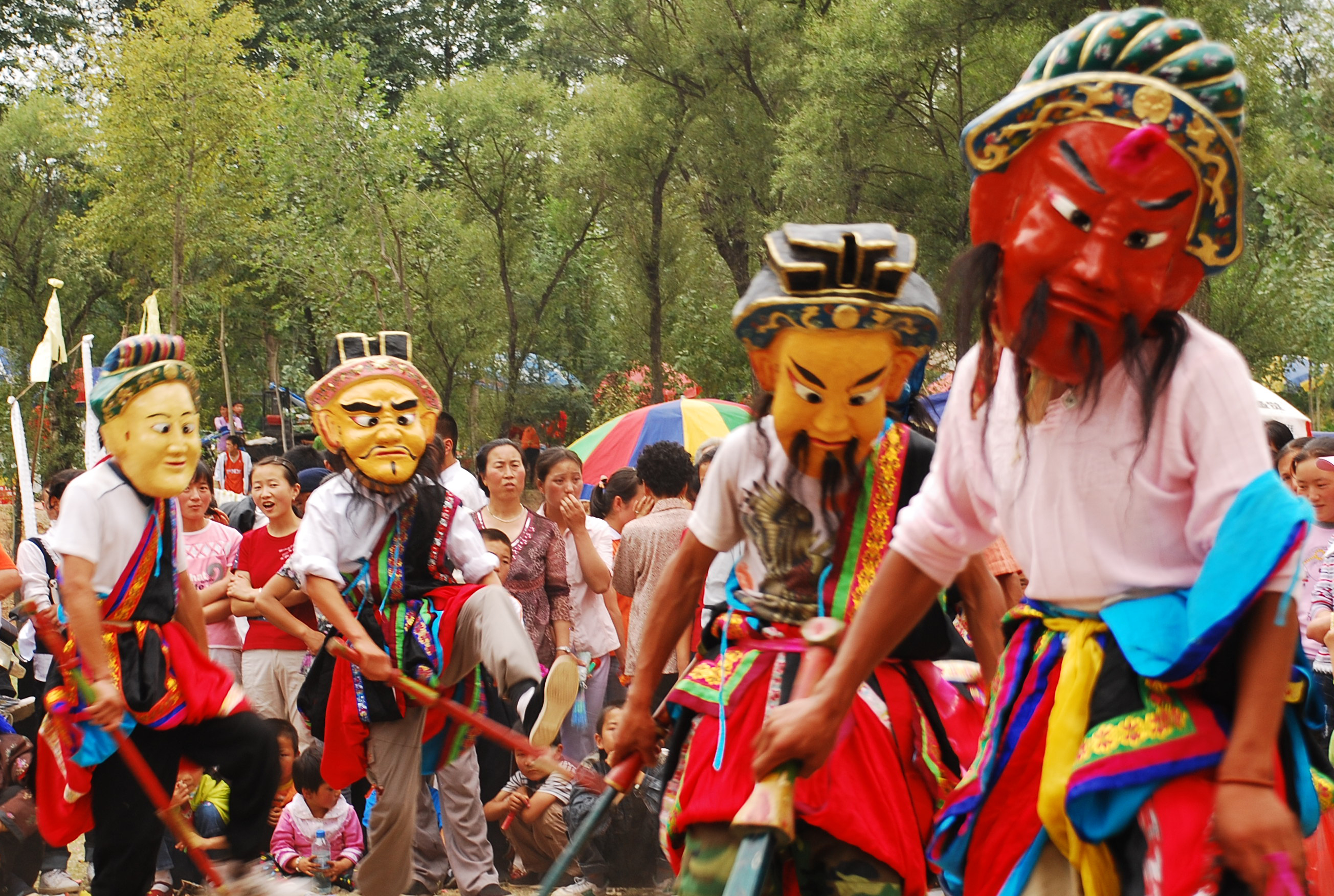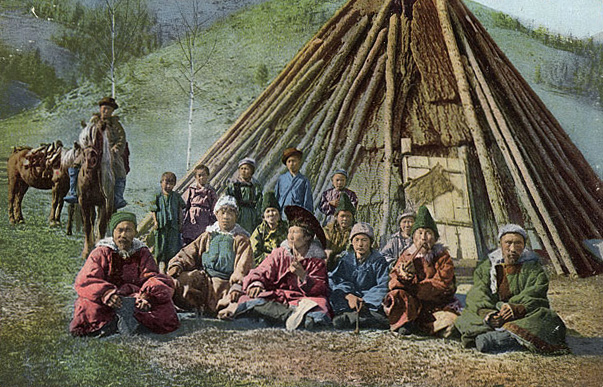|
Gesar
The Epic of King Gesar (), also spelled Kesar () or Geser (especially in Mongolian contexts), is an epic from Tibet and Central Asia. It originally developed between 200 or 300 BCE and about 600 CE. Folk balladeers continued to pass on the story orally; this enriched the plot and embellished the language. The story reached its "final" form and height of popularity in the early 12th century. The epic relates the heroic deeds of the culture hero Gesar, the fearless lord of the legendary kingdom of Ling (). It is recorded variously in poetry and prose, through oral poetry performance, and is sung widely throughout Central Asia and South Asia. Its classic version is found in central Tibet. Some 100 bards of this epic (, "tale") are still active today in the Gesar belt of China. Tibetan, Mongolian, Buryat, Balti, Ladakhi, and Monguor singers maintain the oral tradition, and the epic has attracted intense scholarly curiosity as one of the few oral epic traditions to survive as ... [...More Info...] [...Related Items...] OR: [Wikipedia] [Google] [Baidu] |
Tibetan People
Tibetans () are an East Asian people, East Asian ethnic group Indigenous peoples, native to Tibet. Their current population is estimated to be around 7.7 million. In addition to the majority living in the Tibet Autonomous Region of China, significant numbers of Tibetans live in the provinces of China, Chinese provinces of Gansu, Qinghai, Sichuan, and Yunnan, as well as in Bhutan, Tibetan refugees in India, India, and Nepal. The Tibetic languages belong to the Tibeto-Burman languages, Tibeto-Burman language group. The traditional or mythological explanation of the Tibetan people's origin is that they are the descendants of the human Pha Trelgen Changchup Sempa and rock ogress Ma Drag Sinmo. It is thought that most of the Tibeto-Burman speakers in southwest China, including Tibetans, are direct descendants from the Qiang (historical people), ancient Qiang people. Most Tibetans practice Tibetan Buddhism, although a significant minority observe the Indigenous Bon religion. There ... [...More Info...] [...Related Items...] OR: [Wikipedia] [Google] [Baidu] |
Epic Poetry
In poetry, an epic is a lengthy narrative poem typically about the extraordinary deeds of extraordinary characters who, in dealings with gods or other superhuman forces, gave shape to the mortal universe for their descendants. With regard to oral tradition, epic poems consist of formal speech and are usually learnt word for word, and are contrasted with narratives that consist of everyday speech where the performer has the license to recontextualize the story to a particular audience, often to a younger generation. Influential epics that have shaped Western literature and culture include Homer's ''Iliad'' and '' Odyssey''; Virgil's '' Aeneid''; and the anonymous '' Beowulf'' and '' Epic of Gilgamesh''. The genre has inspired the adjective '' epic'' as well as derivative works in other mediums (such as epic films) that evoke or emulate the characteristics of epics. Etymology The English word ''epic'' comes from Latin , which itself comes from the Ancient Greek adject ... [...More Info...] [...Related Items...] OR: [Wikipedia] [Google] [Baidu] |
Tibet
Tibet (; ''Böd''; ), or Greater Tibet, is a region in the western part of East Asia, covering much of the Tibetan Plateau and spanning about . It is the homeland of the Tibetan people. Also resident on the plateau are other ethnic groups such as Mongols, Monpa people, Monpa, Tamang people, Tamang, Qiang people, Qiang, Sherpa people, Sherpa, Lhoba people, Lhoba, and since the 20th century Han Chinese and Hui people, Hui. Tibet is the highest region on Earth, with an average elevation of . Located in the Himalayas, the highest elevation in Tibet is Mount Everest, Earth's highest mountain, rising above sea level. The Tibetan Empire emerged in the 7th century. At its height in the 9th century, the Tibetan Empire extended far beyond the Tibetan Plateau, from the Tarim Basin and Pamirs in the west, to Yunnan and Bengal in the southeast. It then divided into a variety of territories. The bulk of western and central Tibet (Ü-Tsang) was often at least nominally unified under a ser ... [...More Info...] [...Related Items...] OR: [Wikipedia] [Google] [Baidu] |
Baltistan
Baltistan (); also known as Baltiyul or Little Tibet, is a mountainous region in the Pakistani-administered territory of Gilgit-Baltistan and constitutes a northern portion of the larger Kashmir region that has been the subject of a dispute between India and Pakistan since 1947. It is located near the Karakoram (south of K2) and borders Gilgit to the west, China's Xinjiang to the north, Indian-administered Ladakh to the southeast, and the Indian-administered Kashmir Valley to the southwest. The average altitude of the region is over . Baltistan is largely administered under the Baltistan Division. Prior to the partition of British India in 1947, Baltistan was part of the princely state of Jammu and Kashmir, having been conquered by Gulab Singh's armies in 1840. Baltistan and Ladakh were administered jointly under one ''wazarat'' (district) of the state. The region retained its identity in this setup as the Skardu ''tehsil'', with Kargil and Leh being the other two ''tehs ... [...More Info...] [...Related Items...] OR: [Wikipedia] [Google] [Baidu] |
Monguor People
The Monguor people ( Monguor: Mongghul), also known as Tu people (), White Mongol or Tsagaan Mongol, are a Mongolic people and one of the 56 officially recognized ethnic groups in China. According to the 2000 census, the total population was 241,198, who mostly lived in the Qinghai and the Gansu provinces. The 2010 census gave their number as 289,565. The Monguor people speak the Monguor language, which belongs to the family of Mongolic languages but has been heavily influenced by both the local Chinese and Tibetan dialects. Today, nearly all Tu people also speak Chinese. Most are farmers and some keep livestock. Their culture and the social organizations have been influenced by Tibetan Buddhism, Confucianism, Taoism and local beliefs. A few Tu in Huzhu and Minhe are Christian, the result of on-going American and Korean missionary work in the area. Ethnic origins The ethnic history of the Monguor is contested. It has been variously suggested that their origins are relate ... [...More Info...] [...Related Items...] OR: [Wikipedia] [Google] [Baidu] |
Tungusic Peoples
Tungusic peoples are an ethnolinguistic group formed by the speakers of Tungusic languages (or Manchu–Tungus languages). They are native to Siberia, Mongolia and China. The Tungusic language family is divided into two main branches, Northern ( Ewenic– Udegheic) and Southern Tungusic ( Jurchenic– Nanaic). Name The name ''Tungusic'' is artificial, and properly refers just to the linguistic family (Tungusic languages). It is derived from Russian (), a Russian exonym for the Evenks (Ewenki). English usage of ''Tungusic'' was introduced by Friedrich Max Müller in the 1850s, based on earlier use of German by Heinrich Julius Klaproth. The alternative term ''Manchu–Tungus'' is also in use ( 'Tunguso-Manchurian'). The name ''Tunguska'', a region of eastern Siberia bounded on the west by the Tunguska rivers and on the east by the Pacific Ocean, has its origin from the Tungus people (Evenks). [...More Info...] [...Related Items...] OR: [Wikipedia] [Google] [Baidu] |
Nepal
Nepal, officially the Federal Democratic Republic of Nepal, is a landlocked country in South Asia. It is mainly situated in the Himalayas, but also includes parts of the Indo-Gangetic Plain. It borders the Tibet Autonomous Region of China China–Nepal border, to the north, and India India–Nepal border, to the south, east, and west, while it is narrowly separated from Bangladesh by the Siliguri Corridor, and from Bhutan by the States and union territories of India, Indian state of Sikkim. Nepal has a Geography of Nepal, diverse geography, including Terai, fertile plains, subalpine forested hills, and eight of the world's ten List of highest mountains#List, tallest mountains, including Mount Everest, the highest point on Earth. Kathmandu is the nation's capital and List of cities in Nepal, its largest city. Nepal is a multi-ethnic, multi-lingual, multi-religious, and multi-cultural state, with Nepali language, Nepali as the official language. The name "Nepal" is first record ... [...More Info...] [...Related Items...] OR: [Wikipedia] [Google] [Baidu] |
Altai People
The Altai people (, ), also the Altaians (, ), are a Turkic peoples, Turkic ethnic group of indigenous peoples of Siberia mainly living in the Altai Republic, Russia. Several thousand of the Altaians also live in Mongolia (Altai Mountains) and China (Altay Prefecture, Xinjiang) but are Unrecognized ethnic groups in China, not officially recognized as a distinct group and listed under the name "Oirats" as a part of the Mongols, as well as in Kazakhstan where they number around 200. For alternative ethnonyms see also Tiele people, Tele, Qarai Turks, Black Tatar, and Oirats. During the Northern Yuan, Northern Yuan dynasty, they were ruled in the administrative area known as Telengid Province. Ethnic groups and subgroups The Altaians are represented by two ethnographic groups: * The Northern Altaians, who speak the Northern Altai language and dialects, include the Chelkans, Kumandins, and Tubalars (Tuba-Kizhi). * The Southern Altaians, who speak the Southern Altai language with i ... [...More Info...] [...Related Items...] OR: [Wikipedia] [Google] [Baidu] |
Turkic Peoples
Turkic peoples are a collection of diverse ethnic groups of West Asia, West, Central Asia, Central, East Asia, East, and North Asia as well as parts of Europe, who speak Turkic languages.. "Turkic peoples, any of various peoples whose members speak languages belonging to the Turkic subfamily...". "The Turkic peoples represent a diverse collection of ethnic groups defined by the Turkic languages." According to historians and linguists, the Proto-Turkic language originated in Central-East Asia, potentially in the Altai-Sayan region, Mongolia or Tuva.: "The ultimate Proto-Turkic homeland may have been located in a more compact area, most likely in Eastern Mongolia": "The best candidate for the Turkic Urheimat would then be northern and western Mongolia and Tuva, where all these haplogroups could have intermingled, rather than eastern and southern Mongolia..." Initially, Proto-Turkic speakers were potentially both hunter-gatherers and farmers; they later became nomadic Pastoralism, ... [...More Info...] [...Related Items...] OR: [Wikipedia] [Google] [Baidu] |
Caesar (title)
Caesar ( English language, English Caesars; Latin ; in Greek: ) is a title of imperial character. It derives from the ''cognomen'' of Julius Caesar. The change from being a surname to a title used by the Roman emperors can be traced to AD 68, following the fall of the Julio-Claudian dynasty. When used on its own, the title denoted heirs apparent, who would later adopt the title ''Augustus (title), Augustus'' on accession. The title remained an essential part of the style of the emperors, and became the word for "emperor" in some languages, such as German () and Slavic (). Origins The first known individual to bear the ''cognomen'' of "Caesar" was Sextus Julius Caesar (praetor 208 BC), Sextus Julius Caesar, who is likewise believed to be the common ancestor of all subsequent Julii Caesares. Sextus's great-grandson was the dictator Julius Caesar, Gaius Julius Caesar, who seized control of the Roman Republic following his Caesar's civil war, war against the Roman Senate ... [...More Info...] [...Related Items...] OR: [Wikipedia] [Google] [Baidu] |
Beijing
Beijing, Chinese postal romanization, previously romanized as Peking, is the capital city of China. With more than 22 million residents, it is the world's List of national capitals by population, most populous national capital city as well as China's List of cities in China by population, second largest city by urban area after Shanghai. It is located in North China, Northern China, and is governed as a Direct-administered municipalities of China, municipality under the direct administration of the Government of the People's Republic of China, State Council with List of administrative divisions of Beijing, 16 urban, suburban, and rural districts.Figures based on 2006 statistics published in 2007 National Statistical Yearbook of China and available online at archive. Retrieved 21 April 2009. Beijing is mostly surrounded by Hebei Province and neighbors Tianjin to the southeast; together, the three divisions form the Jing-Jin-Ji, Jing-Jin-Ji cluster. Beijing is a global city and ... [...More Info...] [...Related Items...] OR: [Wikipedia] [Google] [Baidu] |









